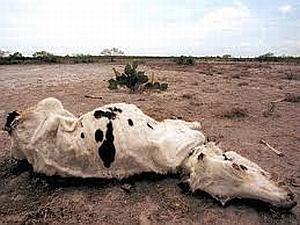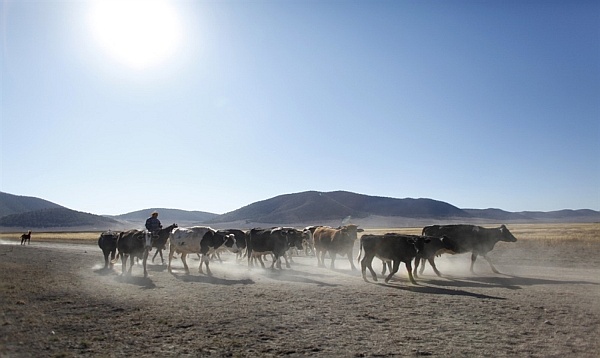Chihuahua, Mexico - A severe drought in Mexico that has cost farmers more than a billion dollars in crop losses alone and set back the national cattle herd for years, is just a foretaste of the drier future facing Latin America's second largest economy.
As water tankers race across northern Mexico to reach remote towns, and crops wither in the fields, the government has allotted $34 billion pesos ($2.65 USD) in emergency aid to confront the worst drought ever recorded in the country.
The water shortage wiped out millions of acres of farmland this winter, caused $15 billion pesos ($1.18 billion) in lost harvests, killed 60,000 head of cattle and weakened 2 million more livestock, pushing food prices higher in Mexico.
The overall cost to the economy is still being gauged, but Mexico's drought-stung winter has been evolving for years and is expected to worsen as the effect of global climate change takes hold, according to the government.
"Droughts are cyclical, we know that, but they are growing more frequent and severe due to climate change," said Elvira Quesada, Minister of Environment and Natural Resources.
According to Mexico's AMSDA agricultural association, poor weather destroyed some 7.5 million acres (3 million hectares) of cultivable land in 2011, an area about the size of Belgium. The federal agriculture ministry puts the figure at about half that.
That helped push Mexico's food imports up 35% last year, a trend likely to persist through the 2012-13 crop cycle.
"There was talk of drought when I got here sixteen years ago," said Ignacio Becerra, a priest working in the rugged town of Carichi in Chihuahua state, which has suffered massive water shortages. "This year, not even corn or beans came up. Watering holes that never ran dry are empty. Without rain this situation is going to get even more serious."
Zacatecas state, the country's main bean producer, harvested only a quarter of the usual crop after months without rain.
Agriculture Minister Fransisco Mayorga said this week that Mexico will produce 21.8 million metric tons of corn in 2012 after a sharp drop in production in 2011 to 19.2 million, due to the drought. The country may have to import white corn, used to make corn tortillas, on top of yellow corn imports from the US for animal feed.
The water shortage has forced Mexican farmers to cut back cattle herds as pasture lands dry out and increased the risk of wildfires, which ravaged northern Mexico and the southern United States last spring.
 |
| The water shortage has wiped out 60,000 head of Mexican cattle. |
Mexican President Felipe Calderon, an outspoken advocate for mitigating and adapting to climate change, has ordered his government to start getting ready for tougher times.
Experts believe Mexico will have to spend billions of dollars in the next two decades to maintain the water supply for irrigation and drinking water. Mexico's Water Commission, Conagua, says it must invest over $300 billion pesos ($23.68 billion USD) by 2030 to safeguard and modernize infrastructure by sealing leaky pipes, expanding reservoirs, and even recycling household waste water.
As policymakers plot their response to climate change, Mexicans must simply come to grip with years of little rain and higher food bills for staples like beef.
Darrell Hargrove, owner of farming and trucking firm Southwest Livestock in Del Rio, Texas, said the price of Mexican cattle for export to the United States had jumped by about a third over the last month and a half.
Rising demand and shrinking herds in Mexico and the US, raised the basic price for a 300 lb head of cattle to about $2 per lb from $1.50 since February. Official data shows total livestock prices in Mexico were up by some 12.5% on the year in February. "We have the lowest cattle herd count here that we've had since about 1950," Hargrove said.
Ranchers in Chihuahua are watching their herds wither from malnutrition and say sick cows will have trouble reproducing, causing losses that could take a decade to recover.
The human cost has also been harsh.
The government said it provided food rations to more than two million people, though agricultural group AMSDA said 8 million people had been affected by the lack of water.
More than 400,000 residents in the six driest states were without water at the end of December, Conagua said, with reservoirs in two states half-empty and another two less than a quarter full.
The indigenous Tarahumara people of northern Mexico suffered particularly hard, with tens of thousands of poor families hit. The government says it delivered millions of liters of milk and tons of food, but the situation is acute.
"This year the Tarahumaras have not been able to harvest corn or beans, which is the basis of their livelihood," said local priest Becerra, "And the worst is yet to come. April, May, June, and July are the driest and hottest months of the year. The situation will become much more serious and complex."
Deforestation worsened conditions for indigenous people around the copper canyon in Chihuahua and many have left for cities to escape poverty and hunger.
"We're at the point of no return. The northern part of the country is drying out. If the rains don't come, the situation is going to be worse than serious. It will be a disaster," Becerra said.
While rain-starved communities pray for a downpour that would replenish wells and reservoirs, experts say the northern half of Mexico is in a persistent dry cycle.
"The current drought was probably unfolding 20 years ago," said Fernando Miralles-Wilhelm, a hydrologist with the Inter-American Development Bank (IADB)."These dynamics are going to continue for the next few decades."
The IADB, which works in Latin America and the Caribbean, promises $1 out of every $4 it lends over the next three years will go to conservation as well as adapting and mitigating climate change. The bank lent nearly $11 billion last year.
A fleet of several thousands trailers is making round-the-clock trips in a race to get clean water to remote communities, but it may not be enough if the drought wears on. Summer rains typically break the winter dry spell but Conagua expects March rainfall to be half of normal years and it does not see a break to the crisis before July.


